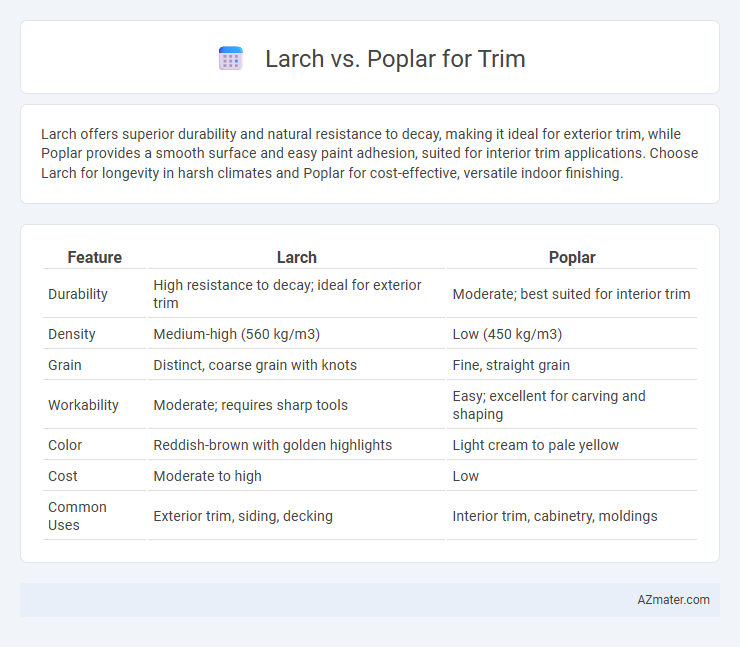Larch offers superior durability and natural resistance to decay, making it ideal for exterior trim, while Poplar provides a smooth surface and easy paint adhesion, suited for interior trim applications. Choose Larch for longevity in harsh climates and Poplar for cost-effective, versatile indoor finishing.
Table of Comparison
| Feature | Larch | Poplar |
|---|---|---|
| Durability | High resistance to decay; ideal for exterior trim | Moderate; best suited for interior trim |
| Density | Medium-high (560 kg/m3) | Low (450 kg/m3) |
| Grain | Distinct, coarse grain with knots | Fine, straight grain |
| Workability | Moderate; requires sharp tools | Easy; excellent for carving and shaping |
| Color | Reddish-brown with golden highlights | Light cream to pale yellow |
| Cost | Moderate to high | Low |
| Common Uses | Exterior trim, siding, decking | Interior trim, cabinetry, moldings |
Introduction to Larch and Poplar for Trim
Larch and poplar are popular wood choices for trim due to their distinct characteristics and workability. Larch offers excellent durability and a rich, warm color with natural resistance to decay, making it suitable for both interior and exterior trim applications. Poplar is favored for its smooth texture, ease of painting, and affordability, providing a versatile option for interior trim that can be stained or painted to match various decor styles.
Botanical Overview: Larch vs Poplar
Larch (genus Larix) is a deciduous conifer known for its needle-like leaves and hardwood qualities, commonly used in exterior trim due to its durability and natural resistance to decay. Poplar (genus Populus) is a fast-growing deciduous hardwood with broad leaves and a softer texture, often selected for interior trim because of its smooth grain and ease of paint adhesion. The contrasting botanical traits of Larch and Poplar directly influence their performance and suitability in trim applications, with Larch favored for strength and weather resistance, while Poplar offers cost-effectiveness and versatility for indoor use.
Appearance and Grain Comparison
Larch wood exhibits a rich, warm reddish-brown hue with prominent, straight grain patterns that create a distinctive, textured appearance ideal for decorative trim. Poplar, on the other hand, offers a lighter cream to pale greenish color with a more uniform and subtle grain, often preferred for painted trim due to its smooth surface. The pronounced grain of larch provides natural character and depth, while poplar's fine, even grain ensures a clean, consistent finish.
Durability and Hardness Differences
Larch exhibits significantly higher durability and hardness compared to poplar, making it more suitable for trim in high-traffic or moisture-prone areas due to its natural resistance to decay and wear. Poplar is softer and less dense, which can lead to faster wear and denting but offers easier workability and lower cost. Choosing larch for trim ensures longer-lasting performance and better impact resistance, while poplar suits budget-friendly projects with less exposure to physical stress.
Workability and Ease of Installation
Larch offers a dense grain and moderate hardness, which provides good workability but requires sharp tools for precision cuts, making it suitable for trim that needs detailed shaping. Poplar is softer and more uniform, allowing easier cutting, sanding, and nailing, which reduces installation time and effort for trim applications. Both woods accept finishes well, but poplar's lighter weight and consistent grain make it the preferred choice for quick, straightforward trim installation.
Resistance to Decay and Moisture
Larch wood offers superior resistance to decay and moisture compared to poplar, thanks to its dense grain and natural resin content, making it ideal for exterior trim applications exposed to weather. Poplar, while lightweight and easy to work with, is more susceptible to moisture absorption and fungal decay, requiring additional treatment or protective finishes for durability in damp conditions. Choosing larch trim ensures longer-lasting performance with less maintenance in environments prone to humidity and rain.
Cost and Availability Analysis
Larch wood is generally more expensive than poplar due to its durability and natural resistance to decay, making it a preferred choice for exterior trim despite higher costs. Poplar trim is widely available and more affordable, making it ideal for interior applications where budget constraints are a priority. Availability of larch can be limited in some regions, while poplar is broadly sourced from North American forests, ensuring consistent supply for contractors.
Environmental Impact and Sustainability
Larch wood is highly sustainable due to its rapid growth and natural resistance to decay, reducing the need for chemical treatments and enhancing environmental benefits in trim applications. Poplar, while also fast-growing, generally requires more intensive chemical processing to improve durability, which can increase its environmental footprint. Choosing larch for trim is an eco-friendly option that supports sustainable forestry and offers long-lasting performance with lower environmental impact.
Best Uses for Larch and Poplar in Trim Projects
Larch wood offers exceptional durability and natural resistance to decay, making it ideal for exterior trim projects exposed to weather elements. Poplar, with its smooth texture and ease of painting, is best suited for interior trim where a clean, paint-ready surface is essential. Choosing Larch for rugged outdoor use and Poplar for detailed, painted indoor trim ensures optimal performance and aesthetic appeal in trim applications.
Final Recommendation: Choosing Between Larch and Poplar for Trim
Larch offers superior durability and natural resistance to decay, making it ideal for trim that requires long-lasting performance, especially in exterior applications. Poplar is favored for its smooth texture and ease of painting, providing a cost-effective option for interior trim with consistent finish quality. For trim selection, prioritize larch when strength and weather resistance are critical, while poplar suits projects emphasizing paintability and budget efficiency.

Infographic: Larch vs Poplar for Trim
 azmater.com
azmater.com